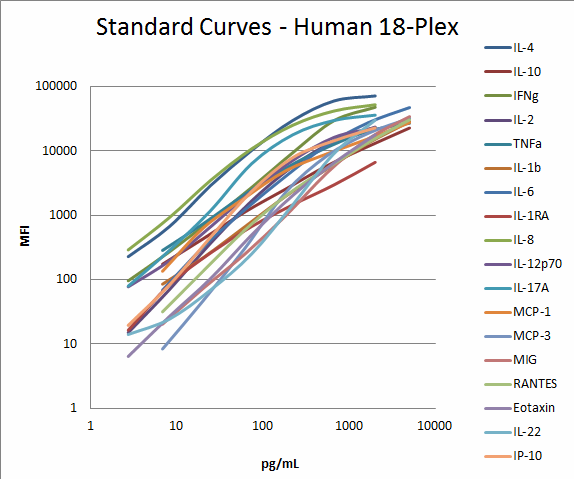How It Works
AimPlex™ multiplex assay technology utilizes multiple bead populations differentiated by size and different levels of fluorescence intensity. With two sizes of beads of 4 and 5 microns and twelve levels of fluorescence intensity in each bead size (4S and 5S), the AimPlex technology can measure up to 24 analytes simultaneously in a single reaction using only 15µL of sample. The bead populations in the reaction are determined using a standard flow cytometer equipped with a blue 488nm and red 635nm laser or with only a 488nm laser. The maximum emission of the bead classification dye is at 700 nm.
Similar to the principle of a sandwich ELISA, each bead population, conjugated with a specific capture antibody, traps the protein of interest, such as a cytokine, in the sample. The amount of the analyte captured is detected via a biotinylated antibody against a secondary epitope of the protein, followed by a streptavidin-R-phycoerythrin treatment. The fluorescent intensity of R-phycoerythrin on the beads is quantified on a flow cytometer equipped with a 488nm laser and measured using the PE channel detector. Concentrations of the protein of interest in the samples can be obtained by comparing the fluorescent signals to those of a standard curve generated from a serial dilution of a known concentration of the protein analyte.
The assay procedure consists of a 60-minute antigen and capture antibody-conjugated bead incubation step, a 30-minute biotinylated detection incubation step and a 20 minute streptavidin-PE incubation step. Washing the beads after each incubation step via a flow-through filter-bottom microplate provides the highest signal-to-noise ratio.
Assay protocol overview
Available Immunoassay Kit Formats
Single-Plex Kits
All available AimPlex™ immunoassays are grouped as 12-24 analytes per group. Each analyte in a group has a unique bead region and can be multiplexed together in any combination. Analytes in different groups may be multiplexed together but may have some cross-reactivity because cross-reactivity of all the assays across different groups was not validated. We offer custom multiplex assay panel design and development. Please contact us for details including pricing and lead time.
Note: Bead set assignment may vary in a panel. Refer to packaging/product inserts and kit labels for details.
Each Single-Plex Kit consists of 1 or more user selectable Analyte Kits, a Basic Kit and a sample matrix specific Diluent Kit. Each Analyte Kit contains analyte specific Ab-conjugated beads, detection antibody(ies) and corresponding antigen standard(s). The Basic Kit has species-specific detection antibody diluent, reading buffer, wash buffer, Streptavidin-PE (SAPE), filter plate and plate seals. The Diluent Kit contains sample-type specific Standard Diluent and sample Assay Buffer. Some of the single-plex kits are available in both 96- and 32-test sizes.
Premixed Multiplex Kits
Each Premixed Multiplex Kit has a predefined multiplex panel with premixed antibody-conjugated beads, antigens and detection antibodies. Except the Reading Buffer (10x) and Wash Buffer (10x), all the reagents are supplied as ready-to-use. Most of the premixed multiplex kits are available in both 96- and 32-test sizes.
Note: Bead set assignment may vary in a panel. Refer to packaging/product inserts and kit labels for details.
Custom Panel/Assay Development and Bulk Packaging
We offer custom premixed panels and custom assay development for analytes not currently available. We will work with you to design the panels and assays. Please contact us for pricing, lead time and details of those offerings.
We also offer custom bulk packaging, usually in a minimum 5-plate size. Please contact us for details.
Video
Assay Specifications
- Sample types: Cell culture supernatant, serum, plasma, bodily fluid and tissue/cell lysate
- Sensitivity (LOD): Majority of the assays < 10 pg/mL
- Quantitation range:
- LLOQ: Majority of the assays < 20 pg/mL
- ULOQ: Majority of the assays > 5,000 pg/mL
- Standard dose recovery: 70-130%
- Precision
- Intra-assay CV: < 10%
- Inter-assay CV: < 20%
- Cross-reactivity of analytes in a panel or group: Negligible
- Sample volume: 15 µL

